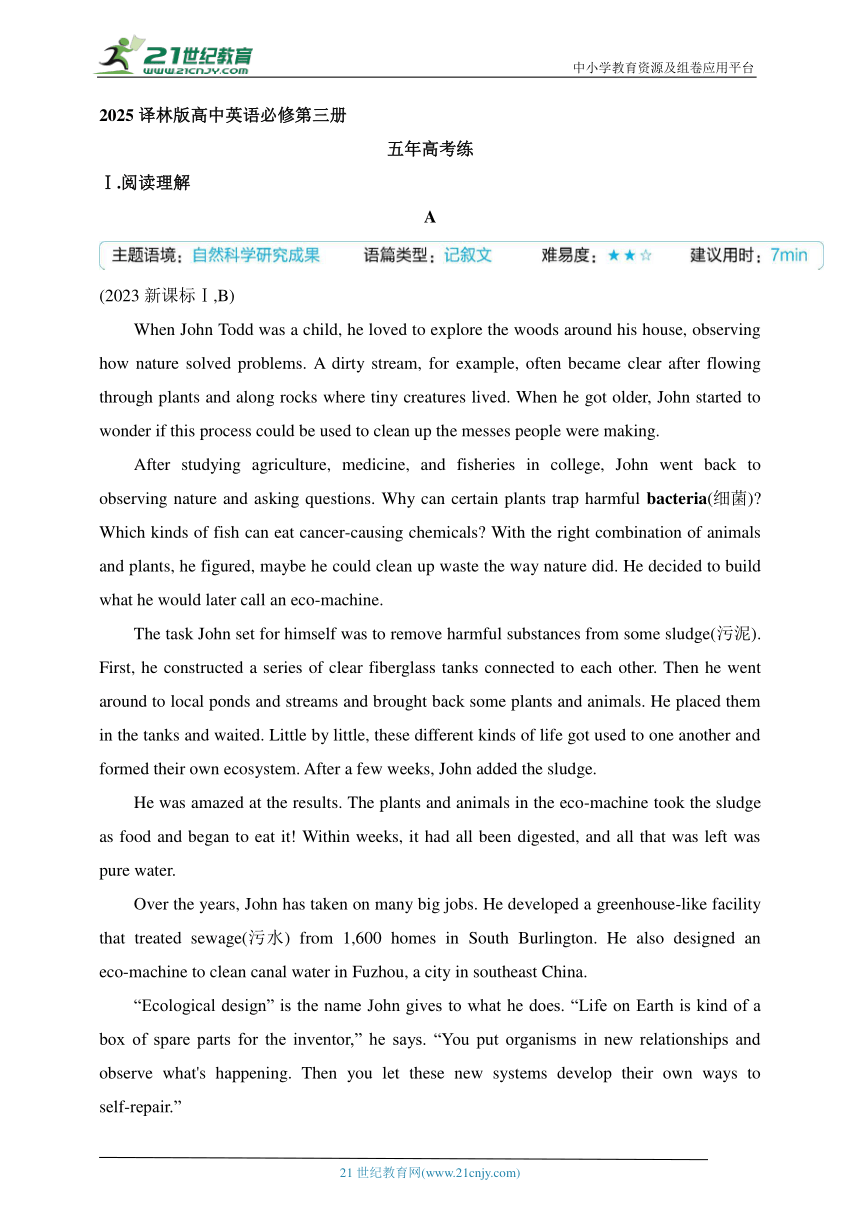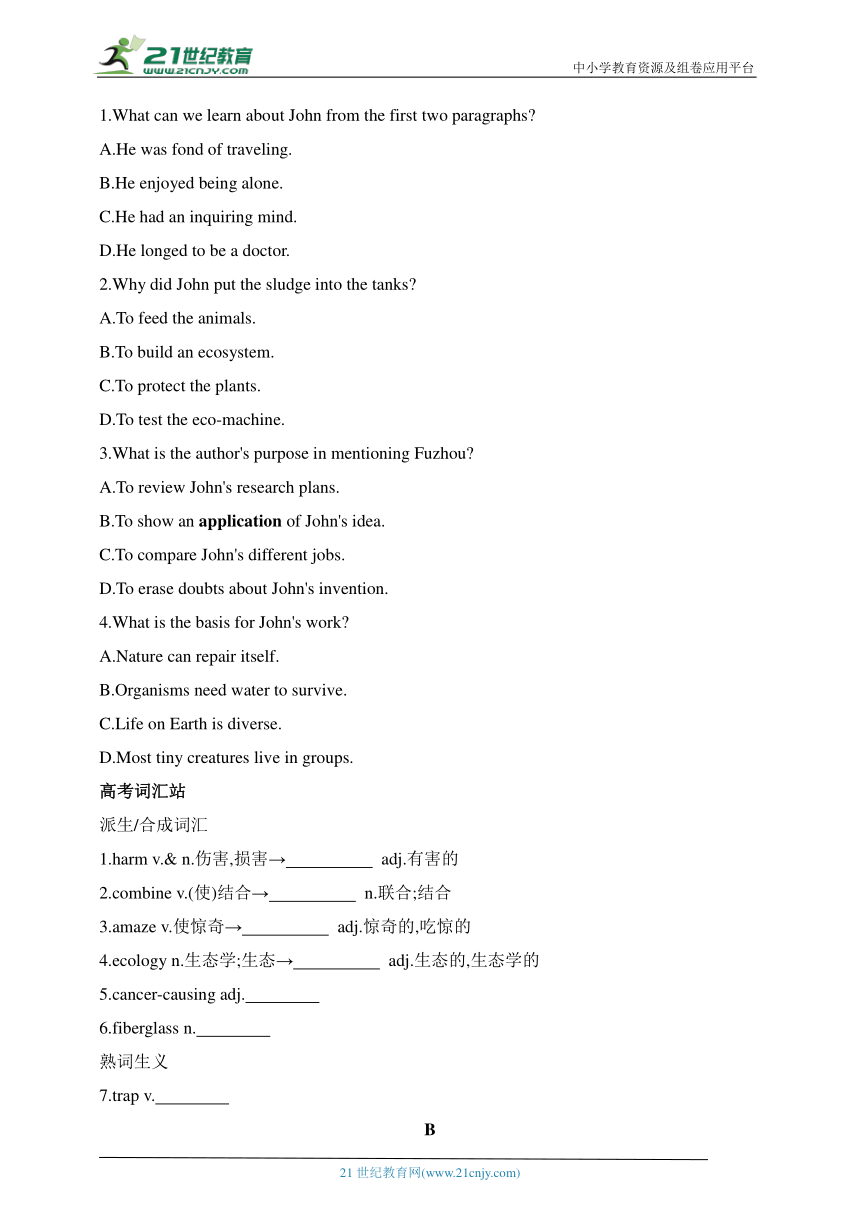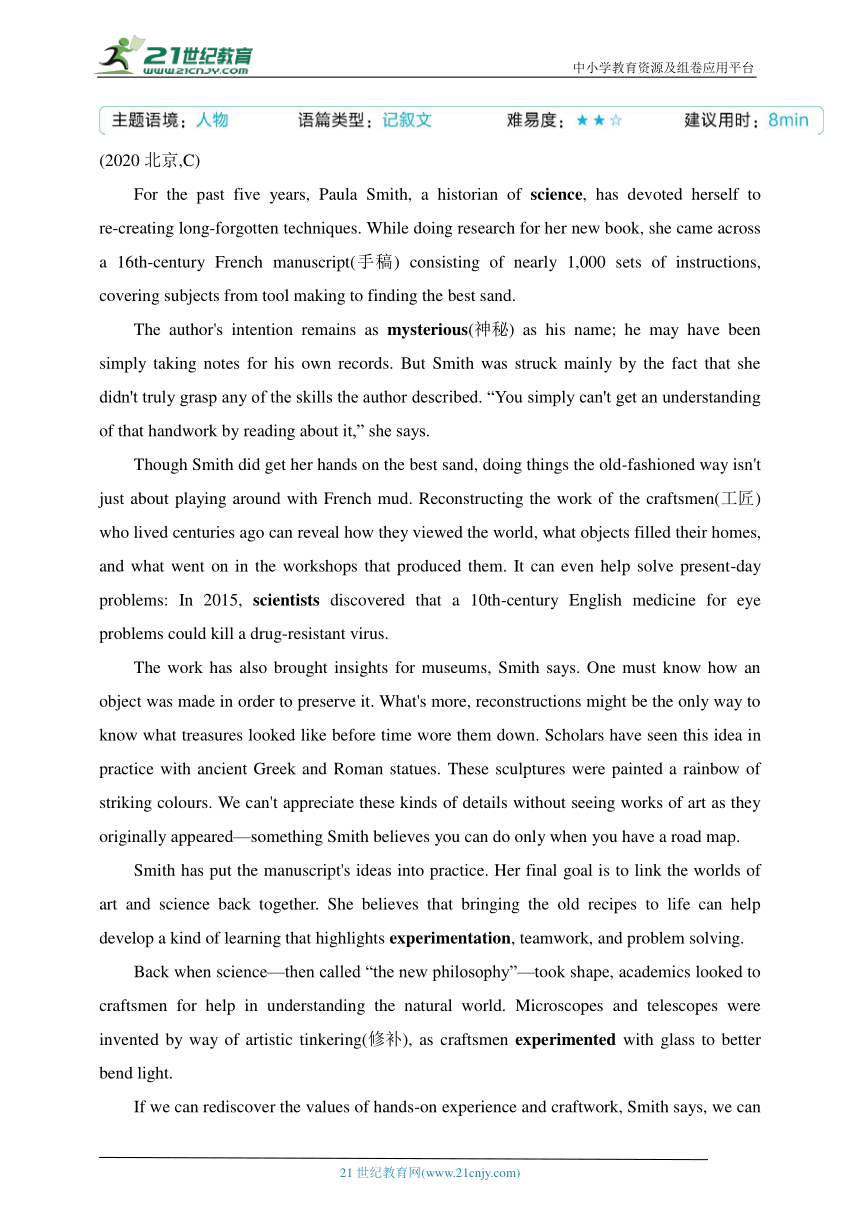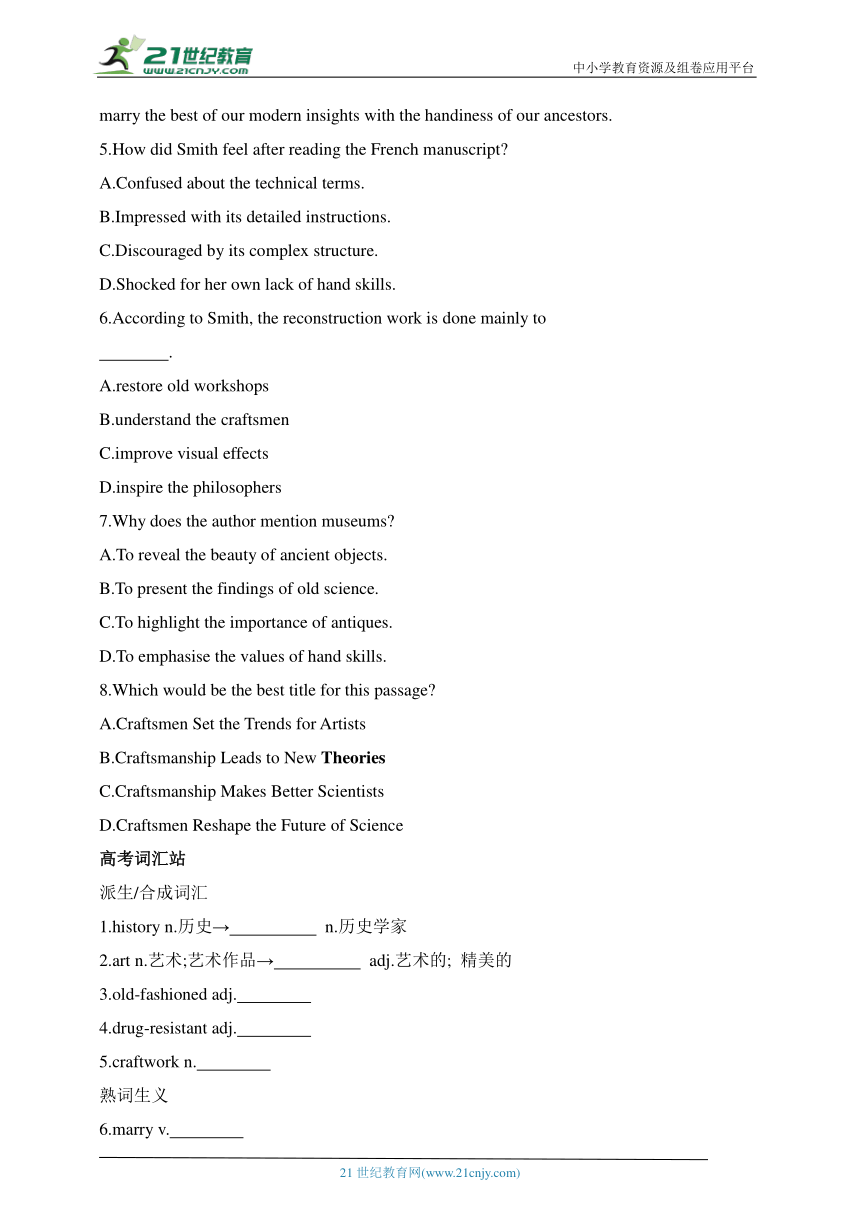2025译林版高中英语必修第三册强化练习题--Unit 4 五年高考练(含答案与解析)
文档属性
| 名称 | 2025译林版高中英语必修第三册强化练习题--Unit 4 五年高考练(含答案与解析) |  | |
| 格式 | docx | ||
| 文件大小 | 326.0KB | ||
| 资源类型 | 试卷 | ||
| 版本资源 | 牛津译林版(2019) | ||
| 科目 | 英语 | ||
| 更新时间 | 2024-11-04 10:49:13 | ||
图片预览




文档简介
中小学教育资源及组卷应用平台
2025译林版高中英语必修第三册
五年高考练
Ⅰ.阅读理解
A
(2023新课标Ⅰ,B)
When John Todd was a child, he loved to explore the woods around his house, observing how nature solved problems. A dirty stream, for example, often became clear after flowing through plants and along rocks where tiny creatures lived. When he got older, John started to wonder if this process could be used to clean up the messes people were making.
After studying agriculture, medicine, and fisheries in college, John went back to observing nature and asking questions. Why can certain plants trap harmful bacteria(细菌) Which kinds of fish can eat cancer-causing chemicals With the right combination of animals and plants, he figured, maybe he could clean up waste the way nature did. He decided to build what he would later call an eco-machine.
The task John set for himself was to remove harmful substances from some sludge(污泥). First, he constructed a series of clear fiberglass tanks connected to each other. Then he went around to local ponds and streams and brought back some plants and animals. He placed them in the tanks and waited. Little by little, these different kinds of life got used to one another and formed their own ecosystem. After a few weeks, John added the sludge.
He was amazed at the results. The plants and animals in the eco-machine took the sludge as food and began to eat it! Within weeks, it had all been digested, and all that was left was pure water.
Over the years, John has taken on many big jobs. He developed a greenhouse-like facility that treated sewage(污水) from 1,600 homes in South Burlington. He also designed an eco-machine to clean canal water in Fuzhou, a city in southeast China.
“Ecological design” is the name John gives to what he does. “Life on Earth is kind of a box of spare parts for the inventor,” he says. “You put organisms in new relationships and observe what's happening. Then you let these new systems develop their own ways to self-repair.”
1.What can we learn about John from the first two paragraphs
A.He was fond of traveling.
B.He enjoyed being alone.
C.He had an inquiring mind.
D.He longed to be a doctor.
2.Why did John put the sludge into the tanks
A.To feed the animals.
B.To build an ecosystem.
C.To protect the plants.
D.To test the eco-machine.
3.What is the author's purpose in mentioning Fuzhou
A.To review John's research plans.
B.To show an application of John's idea.
C.To compare John's different jobs.
D.To erase doubts about John's invention.
4.What is the basis for John's work
A.Nature can repair itself.
B.Organisms need water to survive.
C.Life on Earth is diverse.
D.Most tiny creatures live in groups.
高考词汇站
派生/合成词汇
1.harm v.& n.伤害,损害→ adj.有害的
2.combine v.(使)结合→ n.联合;结合
3.amaze v.使惊奇→ adj.惊奇的,吃惊的
4.ecology n.生态学;生态→ adj.生态的,生态学的
5.cancer-causing adj.
6.fiberglass n.
熟词生义
7.trap v.
B
(2020北京,C)
For the past five years, Paula Smith, a historian of science, has devoted herself to re-creating long-forgotten techniques. While doing research for her new book, she came across a 16th-century French manuscript(手稿) consisting of nearly 1,000 sets of instructions, covering subjects from tool making to finding the best sand.
The author's intention remains as mysterious(神秘) as his name; he may have been simply taking notes for his own records. But Smith was struck mainly by the fact that she didn't truly grasp any of the skills the author described. “You simply can't get an understanding of that handwork by reading about it,” she says.
Though Smith did get her hands on the best sand, doing things the old-fashioned way isn't just about playing around with French mud. Reconstructing the work of the craftsmen(工匠) who lived centuries ago can reveal how they viewed the world, what objects filled their homes, and what went on in the workshops that produced them. It can even help solve present-day problems: In 2015, scientists discovered that a 10th-century English medicine for eye problems could kill a drug-resistant virus.
The work has also brought insights for museums, Smith says. One must know how an object was made in order to preserve it. What's more, reconstructions might be the only way to know what treasures looked like before time wore them down. Scholars have seen this idea in practice with ancient Greek and Roman statues. These sculptures were painted a rainbow of striking colours. We can't appreciate these kinds of details without seeing works of art as they originally appeared—something Smith believes you can do only when you have a road map.
Smith has put the manuscript's ideas into practice. Her final goal is to link the worlds of art and science back together. She believes that bringing the old recipes to life can help develop a kind of learning that highlights experimentation, teamwork, and problem solving.
Back when science—then called “the new philosophy”—took shape, academics looked to craftsmen for help in understanding the natural world. Microscopes and telescopes were invented by way of artistic tinkering(修补), as craftsmen experimented with glass to better bend light.
If we can rediscover the values of hands-on experience and craftwork, Smith says, we can marry the best of our modern insights with the handiness of our ancestors.
5.How did Smith feel after reading the French manuscript
A.Confused about the technical terms.
B.Impressed with its detailed instructions.
C.Discouraged by its complex structure.
D.Shocked for her own lack of hand skills.
6.According to Smith, the reconstruction work is done mainly to
.
A.restore old workshops
B.understand the craftsmen
C.improve visual effects
D.inspire the philosophers
7.Why does the author mention museums
A.To reveal the beauty of ancient objects.
B.To present the findings of old science.
C.To highlight the importance of antiques.
D.To emphasise the values of hand skills.
8.Which would be the best title for this passage
A.Craftsmen Set the Trends for Artists
B.Craftsmanship Leads to New Theories
C.Craftsmanship Makes Better Scientists
D.Craftsmen Reshape the Future of Science
高考词汇站
派生/合成词汇
1.history n.历史→ n.历史学家
2.art n.艺术;艺术作品→ adj.艺术的; 精美的
3.old-fashioned adj.
4.drug-resistant adj.
5.craftwork n.
熟词生义
6.marry v.
Ⅱ.书面表达
(2020全国Ⅰ)
你校正在组织英语作文比赛。请以身边值得尊敬和爱戴的人为题,写一篇短文参赛,内容包括:
1.人物简介;
2.尊敬和爱戴的原因。
注意:
1.词数100左右;
2.短文题目和首句已为你写好。
The person I respect
There are many respectable people around us.
答案与分层梯度式解析
Unit 4 Scientists who changed the world
五年高考练
Ⅰ.A
◎语篇解读 本文是一篇记叙文,主要讲述了约翰·托德(John Todd)自孩童时代就对自然生态感兴趣,致力于此方面研究并应用于实践的经历。
1.C 推理判断题。根据第一段中的explore、started to wonder和第二段中的studying、went back to observing、asking questions可以推断出,约翰·托德自孩童时代就喜欢探究和质疑。故选C。inquiring意为“爱探索的,好奇的”。
2.D 推理判断题。本题问的是John把污泥放进水箱的目的。根据第二段最后一句可知,John决定建造一个生态箱(eco-machine)。第三段主要讲述了John的实验过程(把污泥放进水箱里并观察)。第四段描述实验结果——这个生态箱里的动植物把污泥当成食物吃了。由此可推断出,John把污泥放进水箱的目的是测试他研制的生态箱。故选D。
3.B 推理判断题。根据题干关键词Fuzhou可定位到第五段。根据“John has taken on many big jobs”可知,John已经承担了很多大型工作。紧接着通过他的发明应用于南伯灵顿和福州的例子来说明他的想法在实践中的应用(application)。故选B。
4.A 细节理解题。根据最后一段中的“Then you let these new systems develop their own ways to self-repair.”可知,John的研究依据是自然可以进行自我修复。故选A。
【高考词汇站】 1.harmful 2.combination 3.amazed
4.ecological 5.致癌的 6.玻璃纤维 7.吸收
长难句
原句 When he got older, John started to wonder if this process could be used to clean up the messes people were making.
分析 本句是一个主从复合句。When引导时间状语从句;if引导宾语从句,“people were making”是省略了that的定语从句,修饰messes。
译文 长大后,约翰开始思考这个过程是否可以用来清理人们制造的混乱。
B
◎语篇解读 本文为记叙文。作者通过科学历史学家葆拉·史密斯致力于被遗忘已久的技术这一事例来证明工艺造就了更好的科学家。
5.D 细节理解题。根据第二段第二句可知,让史密斯震惊的主要是,她并没有真正掌握作者所描述的任何技能。可知答案为D项(她为自己缺乏手工技能而感到震惊。)。
6.B 细节理解题。根据第三段第二句“Reconstructing the work of the craftsmen...can reveal how they viewed the world, what objects filled their homes, and what went on in the workshops that produced them.”可知,复原工匠的作品可以揭示他们如何看待世界、他们的家里有什么东西和生产这些东西的工场里发生了什么,故选B项(了解工匠)。
7.D 推理判断题。第三段提到重现古代工匠们的作品的作用,即可以更好地了解他们的世界观、工作及生活环境,第四段指出这些作品也给博物馆带来启示:为了更好地保护文物,博物馆必须了解文物的创作过程,而重现作品可能是了解宝藏原本的样子的唯一方法。由此可推知,作者提及博物馆是为了进一步强调手工技术的重要性,故答案为D项。
8.C 主旨大意题。本文以史密斯致力于被遗忘已久的技术为线索,介绍了工艺对科学的促进,由此可推知最佳题目应为C项(工艺造就了更好的科学家)。
【高考词汇站】 1.historian 2.artistic 3.老式的,过时的 4.耐药的 5.工艺品 6.将……结合在一起
长难句
原句 While doing research for her new book, she came across a 16th-century French manuscript consisting of nearly 1,000 sets of instructions, covering subjects from tool making to finding the best sand.
分析 本句是一个主从复合句。“While doing...book”为状语从句的省略;主句是“she came across...the best sand”,其中“consisting of...instructions”是后置定语,修饰French manuscript,“covering subjects...sand”是现在分词短语作后置定语。
译文 在为她的新书做研究时,她偶然发现了一份16世纪的法国手稿,其中有近一千套说明,涵盖了从工具制作到寻找最好的沙子的主题。
Ⅱ.One possible version:
The person I respect
There are many respectable people around us. As for me, my father is the one I respect. He is a doctor and always takes a positive attitude towards life.
There are various reasons why I admire him. As a doctor, he is devoted to his job, saying “Nothing is more important than saving a life, however difficult it is.” At the critical moment, he always volunteers to take on the toughest tasks, which has made me promote the understanding of bravery and responsibility. As a father, not only does he care about my life, but also he inspires me to set a high aim and strive for it. But for his encouragement, I couldn't have made so much progress.
Such is my father, a great man who sets a good example to me and I love him a great deal.
1.重点词汇
①take a positive attitude towards...对……采取积极的态度 ②various adj.各种各样的 ③take on 承担
④strive for...为……奋斗 ⑤set a good example to...为……树立好的榜样
2.亮点句型
①As a father, not only does he care about my life, but also he inspires me to set a high aim and strive for it.(not only...but also...连接并列分句,not only置于句首,用部分倒装)作为父亲,他不仅在乎我的生活,而且还激励我树立高的目标,并努力去实现它。
②Such is my father, a great man who sets a good example to me and I love him a great deal.(Such置于句首引起倒装,who引导定语从句)这就是我的父亲,一个优秀的人,他为我树立了一个好的榜样,我很爱他。
21世纪教育网 www.21cnjy.com 精品试卷·第 2 页 (共 2 页)
21世纪教育网(www.21cnjy.com)
2025译林版高中英语必修第三册
五年高考练
Ⅰ.阅读理解
A
(2023新课标Ⅰ,B)
When John Todd was a child, he loved to explore the woods around his house, observing how nature solved problems. A dirty stream, for example, often became clear after flowing through plants and along rocks where tiny creatures lived. When he got older, John started to wonder if this process could be used to clean up the messes people were making.
After studying agriculture, medicine, and fisheries in college, John went back to observing nature and asking questions. Why can certain plants trap harmful bacteria(细菌) Which kinds of fish can eat cancer-causing chemicals With the right combination of animals and plants, he figured, maybe he could clean up waste the way nature did. He decided to build what he would later call an eco-machine.
The task John set for himself was to remove harmful substances from some sludge(污泥). First, he constructed a series of clear fiberglass tanks connected to each other. Then he went around to local ponds and streams and brought back some plants and animals. He placed them in the tanks and waited. Little by little, these different kinds of life got used to one another and formed their own ecosystem. After a few weeks, John added the sludge.
He was amazed at the results. The plants and animals in the eco-machine took the sludge as food and began to eat it! Within weeks, it had all been digested, and all that was left was pure water.
Over the years, John has taken on many big jobs. He developed a greenhouse-like facility that treated sewage(污水) from 1,600 homes in South Burlington. He also designed an eco-machine to clean canal water in Fuzhou, a city in southeast China.
“Ecological design” is the name John gives to what he does. “Life on Earth is kind of a box of spare parts for the inventor,” he says. “You put organisms in new relationships and observe what's happening. Then you let these new systems develop their own ways to self-repair.”
1.What can we learn about John from the first two paragraphs
A.He was fond of traveling.
B.He enjoyed being alone.
C.He had an inquiring mind.
D.He longed to be a doctor.
2.Why did John put the sludge into the tanks
A.To feed the animals.
B.To build an ecosystem.
C.To protect the plants.
D.To test the eco-machine.
3.What is the author's purpose in mentioning Fuzhou
A.To review John's research plans.
B.To show an application of John's idea.
C.To compare John's different jobs.
D.To erase doubts about John's invention.
4.What is the basis for John's work
A.Nature can repair itself.
B.Organisms need water to survive.
C.Life on Earth is diverse.
D.Most tiny creatures live in groups.
高考词汇站
派生/合成词汇
1.harm v.& n.伤害,损害→ adj.有害的
2.combine v.(使)结合→ n.联合;结合
3.amaze v.使惊奇→ adj.惊奇的,吃惊的
4.ecology n.生态学;生态→ adj.生态的,生态学的
5.cancer-causing adj.
6.fiberglass n.
熟词生义
7.trap v.
B
(2020北京,C)
For the past five years, Paula Smith, a historian of science, has devoted herself to re-creating long-forgotten techniques. While doing research for her new book, she came across a 16th-century French manuscript(手稿) consisting of nearly 1,000 sets of instructions, covering subjects from tool making to finding the best sand.
The author's intention remains as mysterious(神秘) as his name; he may have been simply taking notes for his own records. But Smith was struck mainly by the fact that she didn't truly grasp any of the skills the author described. “You simply can't get an understanding of that handwork by reading about it,” she says.
Though Smith did get her hands on the best sand, doing things the old-fashioned way isn't just about playing around with French mud. Reconstructing the work of the craftsmen(工匠) who lived centuries ago can reveal how they viewed the world, what objects filled their homes, and what went on in the workshops that produced them. It can even help solve present-day problems: In 2015, scientists discovered that a 10th-century English medicine for eye problems could kill a drug-resistant virus.
The work has also brought insights for museums, Smith says. One must know how an object was made in order to preserve it. What's more, reconstructions might be the only way to know what treasures looked like before time wore them down. Scholars have seen this idea in practice with ancient Greek and Roman statues. These sculptures were painted a rainbow of striking colours. We can't appreciate these kinds of details without seeing works of art as they originally appeared—something Smith believes you can do only when you have a road map.
Smith has put the manuscript's ideas into practice. Her final goal is to link the worlds of art and science back together. She believes that bringing the old recipes to life can help develop a kind of learning that highlights experimentation, teamwork, and problem solving.
Back when science—then called “the new philosophy”—took shape, academics looked to craftsmen for help in understanding the natural world. Microscopes and telescopes were invented by way of artistic tinkering(修补), as craftsmen experimented with glass to better bend light.
If we can rediscover the values of hands-on experience and craftwork, Smith says, we can marry the best of our modern insights with the handiness of our ancestors.
5.How did Smith feel after reading the French manuscript
A.Confused about the technical terms.
B.Impressed with its detailed instructions.
C.Discouraged by its complex structure.
D.Shocked for her own lack of hand skills.
6.According to Smith, the reconstruction work is done mainly to
.
A.restore old workshops
B.understand the craftsmen
C.improve visual effects
D.inspire the philosophers
7.Why does the author mention museums
A.To reveal the beauty of ancient objects.
B.To present the findings of old science.
C.To highlight the importance of antiques.
D.To emphasise the values of hand skills.
8.Which would be the best title for this passage
A.Craftsmen Set the Trends for Artists
B.Craftsmanship Leads to New Theories
C.Craftsmanship Makes Better Scientists
D.Craftsmen Reshape the Future of Science
高考词汇站
派生/合成词汇
1.history n.历史→ n.历史学家
2.art n.艺术;艺术作品→ adj.艺术的; 精美的
3.old-fashioned adj.
4.drug-resistant adj.
5.craftwork n.
熟词生义
6.marry v.
Ⅱ.书面表达
(2020全国Ⅰ)
你校正在组织英语作文比赛。请以身边值得尊敬和爱戴的人为题,写一篇短文参赛,内容包括:
1.人物简介;
2.尊敬和爱戴的原因。
注意:
1.词数100左右;
2.短文题目和首句已为你写好。
The person I respect
There are many respectable people around us.
答案与分层梯度式解析
Unit 4 Scientists who changed the world
五年高考练
Ⅰ.A
◎语篇解读 本文是一篇记叙文,主要讲述了约翰·托德(John Todd)自孩童时代就对自然生态感兴趣,致力于此方面研究并应用于实践的经历。
1.C 推理判断题。根据第一段中的explore、started to wonder和第二段中的studying、went back to observing、asking questions可以推断出,约翰·托德自孩童时代就喜欢探究和质疑。故选C。inquiring意为“爱探索的,好奇的”。
2.D 推理判断题。本题问的是John把污泥放进水箱的目的。根据第二段最后一句可知,John决定建造一个生态箱(eco-machine)。第三段主要讲述了John的实验过程(把污泥放进水箱里并观察)。第四段描述实验结果——这个生态箱里的动植物把污泥当成食物吃了。由此可推断出,John把污泥放进水箱的目的是测试他研制的生态箱。故选D。
3.B 推理判断题。根据题干关键词Fuzhou可定位到第五段。根据“John has taken on many big jobs”可知,John已经承担了很多大型工作。紧接着通过他的发明应用于南伯灵顿和福州的例子来说明他的想法在实践中的应用(application)。故选B。
4.A 细节理解题。根据最后一段中的“Then you let these new systems develop their own ways to self-repair.”可知,John的研究依据是自然可以进行自我修复。故选A。
【高考词汇站】 1.harmful 2.combination 3.amazed
4.ecological 5.致癌的 6.玻璃纤维 7.吸收
长难句
原句 When he got older, John started to wonder if this process could be used to clean up the messes people were making.
分析 本句是一个主从复合句。When引导时间状语从句;if引导宾语从句,“people were making”是省略了that的定语从句,修饰messes。
译文 长大后,约翰开始思考这个过程是否可以用来清理人们制造的混乱。
B
◎语篇解读 本文为记叙文。作者通过科学历史学家葆拉·史密斯致力于被遗忘已久的技术这一事例来证明工艺造就了更好的科学家。
5.D 细节理解题。根据第二段第二句可知,让史密斯震惊的主要是,她并没有真正掌握作者所描述的任何技能。可知答案为D项(她为自己缺乏手工技能而感到震惊。)。
6.B 细节理解题。根据第三段第二句“Reconstructing the work of the craftsmen...can reveal how they viewed the world, what objects filled their homes, and what went on in the workshops that produced them.”可知,复原工匠的作品可以揭示他们如何看待世界、他们的家里有什么东西和生产这些东西的工场里发生了什么,故选B项(了解工匠)。
7.D 推理判断题。第三段提到重现古代工匠们的作品的作用,即可以更好地了解他们的世界观、工作及生活环境,第四段指出这些作品也给博物馆带来启示:为了更好地保护文物,博物馆必须了解文物的创作过程,而重现作品可能是了解宝藏原本的样子的唯一方法。由此可推知,作者提及博物馆是为了进一步强调手工技术的重要性,故答案为D项。
8.C 主旨大意题。本文以史密斯致力于被遗忘已久的技术为线索,介绍了工艺对科学的促进,由此可推知最佳题目应为C项(工艺造就了更好的科学家)。
【高考词汇站】 1.historian 2.artistic 3.老式的,过时的 4.耐药的 5.工艺品 6.将……结合在一起
长难句
原句 While doing research for her new book, she came across a 16th-century French manuscript consisting of nearly 1,000 sets of instructions, covering subjects from tool making to finding the best sand.
分析 本句是一个主从复合句。“While doing...book”为状语从句的省略;主句是“she came across...the best sand”,其中“consisting of...instructions”是后置定语,修饰French manuscript,“covering subjects...sand”是现在分词短语作后置定语。
译文 在为她的新书做研究时,她偶然发现了一份16世纪的法国手稿,其中有近一千套说明,涵盖了从工具制作到寻找最好的沙子的主题。
Ⅱ.One possible version:
The person I respect
There are many respectable people around us. As for me, my father is the one I respect. He is a doctor and always takes a positive attitude towards life.
There are various reasons why I admire him. As a doctor, he is devoted to his job, saying “Nothing is more important than saving a life, however difficult it is.” At the critical moment, he always volunteers to take on the toughest tasks, which has made me promote the understanding of bravery and responsibility. As a father, not only does he care about my life, but also he inspires me to set a high aim and strive for it. But for his encouragement, I couldn't have made so much progress.
Such is my father, a great man who sets a good example to me and I love him a great deal.
1.重点词汇
①take a positive attitude towards...对……采取积极的态度 ②various adj.各种各样的 ③take on 承担
④strive for...为……奋斗 ⑤set a good example to...为……树立好的榜样
2.亮点句型
①As a father, not only does he care about my life, but also he inspires me to set a high aim and strive for it.(not only...but also...连接并列分句,not only置于句首,用部分倒装)作为父亲,他不仅在乎我的生活,而且还激励我树立高的目标,并努力去实现它。
②Such is my father, a great man who sets a good example to me and I love him a great deal.(Such置于句首引起倒装,who引导定语从句)这就是我的父亲,一个优秀的人,他为我树立了一个好的榜样,我很爱他。
21世纪教育网 www.21cnjy.com 精品试卷·第 2 页 (共 2 页)
21世纪教育网(www.21cnjy.com)
同课章节目录
- Unit 1 Nature in the balance
- Welcome to the unit
- Reading
- Grammar and usage
- Integrated skills
- Extended reading
- Project
- Unit 2 Natural disasters
- Welcome to the unit
- Reading
- Grammar and usage
- Integrated skills
- Extended reading
- Project
- Unit 3 The world online
- Welcome to the unit
- Reading
- Grammar and usage
- Integrated skills
- Extended reading
- Project
- Unit 4 Scientists who changed the world
- Welcome to the unit
- Reading
- Grammar and usage
- Integrated skills
- Extended reading
- Project
